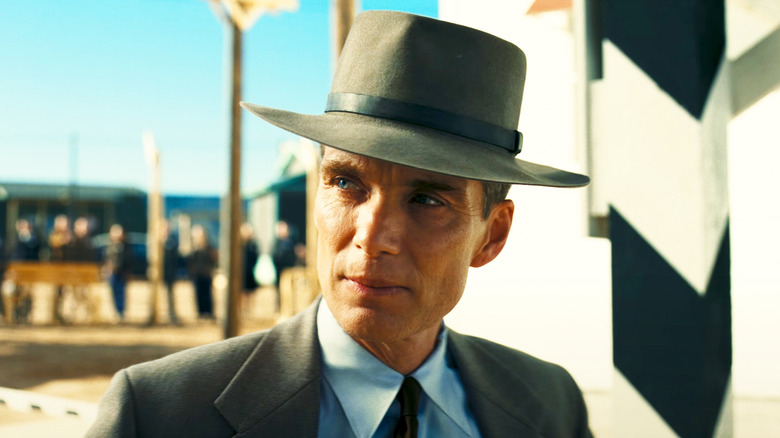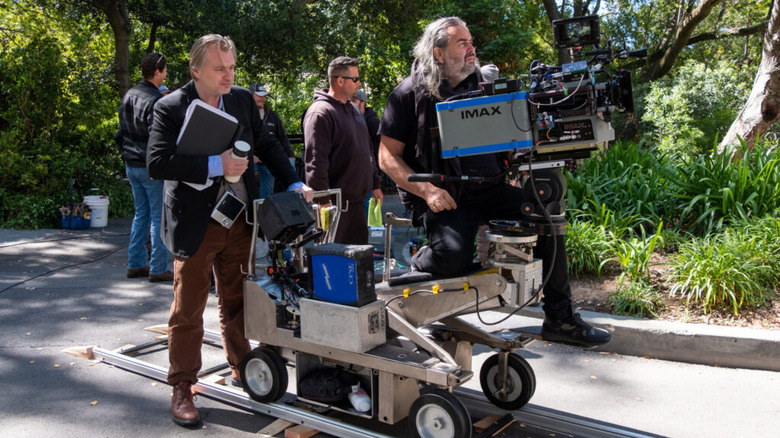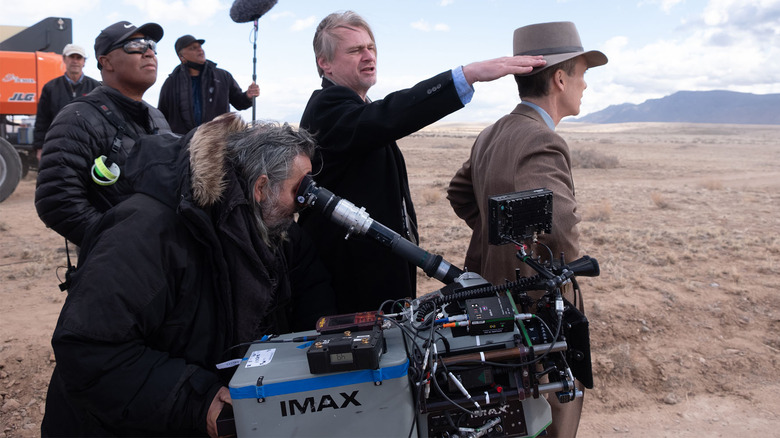Filming Oppenheimer In IMAX Came With A 'Deafening' Quirk No One Was Ready For
No one, besides maybe Quentin Tarantino, has done more to promote shooting on film in our current moment than Christopher Nolan. With "Oppenheimer," the filmmaker outdid himself, shooting his epic three-hour biopic on IMAX 70mm and creating a reel of film that measured 11 miles in length.
As well as promoting film as a viable format in a time where digital dominates movie-making, "Oppenheimer" had its IMAX run extended, seemingly proving that Nolan's efforts were worthwhile. The director even had an entirely new black and white IMAX film invented specifically for his adaptation of Kai Bird and Martin J. Sherwin's J. Robert Oppenheimer biography, "American Prometheus." Whereas previously, Nolan had used IMAX for specific scenes in his films, the entirety of "Oppenheimer" was shot on large-format film (on IMAX 65 mm and 65 mm large-format film), which not only proved useful in showcasing such triumphs as recreating a nuclear explosion without the use of any CGI but provided the director with a unique opportunity to immerse audiences in more intimate moments.
In a behind-the-scenes featurette, Nolan talked about using the "highest quality imaging format that's ever been devised" as a way of taking audiences "into [Oppenheimer's] experience" and achieving a "level of immersion that you can't get from other formats." Cinematographer Hoyte van Hoytema, who's worked with Nolan since 2014's "Interstellar," added:
"IMAX is a format of spectacle and it's made for vistas and for the grandeur of it but I got very curious to discover this as an intimate format. The face is like a landscape there's a huge complexity and a huge depth to it. How can we get this camera closer to people? How can we get this medium to work also as a very intimate medium?"
Which is all well and good. But there was one particular problem the crew didn't necessarily foresee.
The one major issue with using IMAX cameras
"Oppenheimer" has already proven a box office success, soaring past $400 million after just its second weekend in theaters. For a film that features a hell of a lot of men talking sternly in offices, that's pretty impressive. What makes those seemingly drab scenes interesting, however, is not just the gravity of the conversations being had, but the way in which Christopher Nolan and Hoyte van Hoytema treat them as cinematic moments as worthy of large-scale presentation as the Trinity Test itself.
Unfortunately, IMAX cameras aren't the most practical things. In order to shoot on 70mm film, the cameras have giant mags attached, which makes it quite difficult to maneuver them in the often cramped environs of Nolan's "Oppenheimer." The security clearance hearings, for example, which were shot in a real office rather than on a soundstage, required star Cillian Murphy, the various arbitrators, and multiple witnesses to cram into a small room along with the IMAX cameras — something which Murphy claimed to found "very emotional and heavy, but in a brilliant way."
What you might not think of in these instances, however, is how difficult it was for the sound tech to do his job. As it turns out, those giant IMAX cameras aren't the quietest. As Vulture reports, Benny Safdie, who plays Hungarian physicist Edward Teller, "thought something had gone wrong" the first time he heard one of the cameras being fired up. As Hoytema explained to the outlet, "It's a machine that can pull 24 medium-format photography frames per second through a big gauge. And if you have a camera that sounds like a little diesel engine, it's very hard to create some sort of very tender, sensitive, quiet, intimate moment."
It's a Nolan thing
There's something quite funny about Christopher Nolan planning to excavate the most intimate moments in J. Robert Oppenheimer's life, then arriving on set and firing up a giant piece of tech that sounds like some sort of farming equipment. You can hear the cameras in action in various YouTube clips, and they do indeed sound like a "diesel engine," to use Hoyt van Hoytema's phrase.
But while their unusual loudness might have been distracting, the cameras also provided benefits beyond being able to capture the clearest image possible. Robert Downey Jr., who plays chairman of the Atomic Energy Commission Lewis Strauss, recalled shooting a scene in the back of a car, which required him to share the small space with an IMAX camera, and found the practicality of the whole thing a revelatory experience. He said:
"I was sitting in the back of a '47 Packard with an IMAX mag on my lap trying to get this driving shot. And I just felt like I went back to some origins of great cinema school, because these lenses are coming at you and they're this close and it wakes you up."
Using these intrusive yet immersive cameras was really just the culmination of Nolan's previous efforts to preserve practical filmmaking efforts in his work. "Oppenheimer" was the first time he'd used IMAX cameras for an entire film, which alongside his insistence on not using CGI for the Trinity Test and the numerous other practical effects he used, is just another reason "Oppenheimer" is the most Christopher Nolan film ever made.


